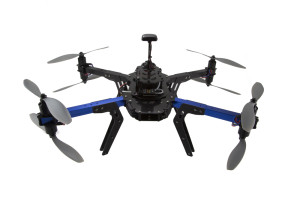I’ve been looking into drones recently. I went to the SF Drones Start-up Meet-up, where I met the most bullish people in the UAV market, and I’ve been doing other meetings and research too.
I’m almost as bullish as the drone start-up people are – it’s a pretty wild-eyed group, but they are right all the same. I met everyone from a guy who is not delivering pot with drones, to a guy who made Uber for drone pilots, and saw a presentation on a high-powered tiny computer that’s like an Arduino on steroids – a little computer I might need for my drone idea. I got a chance to learn about a piece of radio hardware that will let most anyone fly a drone with an iPad from Fighting Walrus. I also met someone I already follow on Twitter, Colin Snow the Drone Analyst.
Seeing the demo of a drone fly and land on its contact charging pad (SkySense) was a thrill too – SkySense uses a clever hex pattern to ensure proper connection of charging contacts.

Photo from SkySense.com, of a Farm Drone
Drones will see commercialization and widespread use in the next 5 years, and drones will likely be the most common robot, kicking off the robotics age with a bang. The major tech advance that made this possible is the advent of cheap multi-copters. Unlike traditional remote controlled and autonomous airplanes and helicopters, multi-copters can withstand mechanical failure in flight without falling out of the sky, withstand high winds and hover in adverse conditions, and can be produced at such low rates that they can be sold for as little as $400 dollars, or even $1000-2000 for best-in-class consumer drones from 3D Robotics or DJI.
You can fly one of these cheap drones around for 40 minutes at a time with stock hardware, and fly it for 50 hours without need for major mechanical repair. As these numbers creep higher and maintenance gets easier, drones will become more and more useful for doing daily or weekly tasks.
The most obvious use for commercial drones is information gathering. This includes maps, photo imagery, real-time and recorded video, and even multi-spectral imaging for purposes like farming (e.g. to detect fungus on crops for treatment). Drones will widely replace security personnel, be used to make farming more efficient, and inspect remote infrastructure like pipelines and dangerous places in nuclear plants. The sweet spot for this new class of multi-copter drone is applications where you need to run a drone day in and day out, repetitively. That’s why drones will come to replace security guards and help farmers in ways that older styles of autonomous flying vehicles weren’t appropriate for. We’ll continue to use fixed-wing drones, airplanes, and satellites to do imaging that doesn’t require as much recency and repetition, but multi-copters are the thing you put on a cron job.
Similarly, doing routine non-surveillance tasks like watering crops and delivering fertilizer will also get droned, just at a slower rate because it’s a harder challenge with more stuff to build correctly. Before you see Amazon delivering packages with drones, you’ll see businesses using drones on private premises for mechanical tasks.
For my part, I’ll leave the hardware to everyone else. I see a lot of room to make software for this emerging drone market, and I might know more about maps, sensors, and software for remote places than the people in the market, even if I don’t have a drone.
